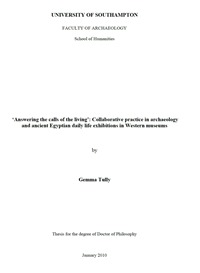| Main » Ad Board » ДРЕВЕН ЕГИПЕТ И АФРИКА » Египтология и история на откритията |
Gemma Tully - 'Answering the calls of the living’
| 09.07.2020, 07:29 | |
Според автора на дисертацията, основна грешка на традиционния начин, по който западните музеи представят миналото на отминалите цивилизации е фокусът им върху монументалността, величието, личностите-лидери и религията. Всички тези белези са резултат от специфичното световъзприемане от XIX век, което игнорира обикновената личност и нейното ежедневие за сметка на държавността, "висшите цели" и национализма. - на английски език, от University of Southampton Institutional Research Repository, ePrints Soton, формат PDF.Сваляне с ляв бутон (downloading by left button) и после през бутона Download. АЛТЕРНАТИВЕН ЛИНК / ALTERNATIVE LINK: - на английски език, от Google Drive,формат PDF. Сваляне с ляв бутон (downloading by left button) от страницата на предоставящия сървър, после през бутона стрелка надолу/after by down arrow button.
| |
| Views: 548 | Placed till: 09.08.2020 | Rating: 0.0/0 | |

